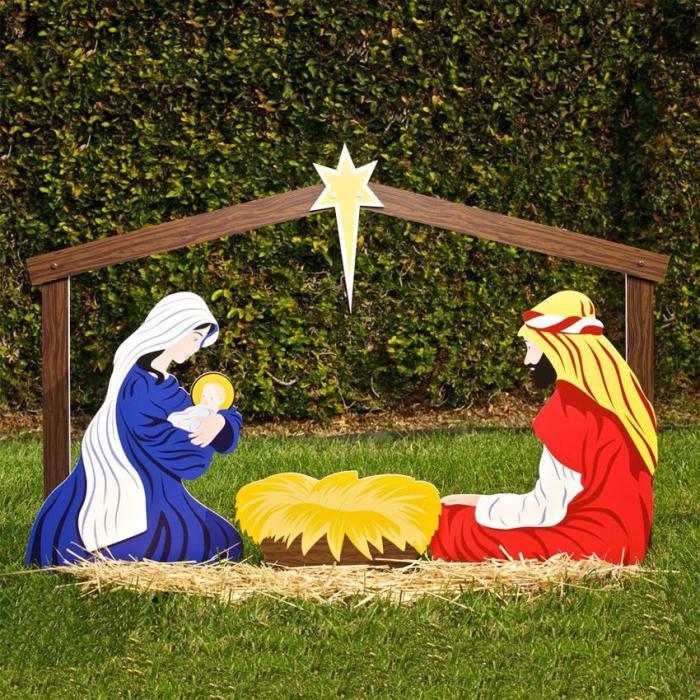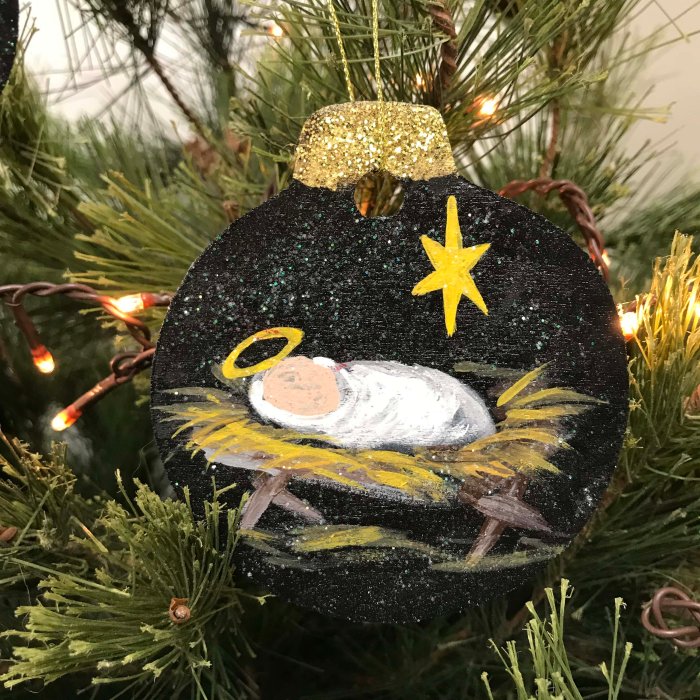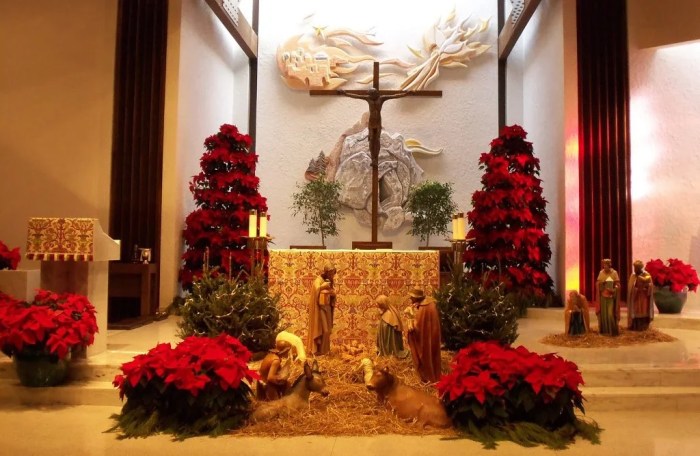Christian Christmas Decorations: From the humble nativity scene to dazzling modern interpretations, the ways Christians celebrate Christmas through décor reflect a rich tapestry of history, faith, and artistic expression. This guide explores the evolution of these decorations, delving into their religious symbolism, crafting techniques, and display ideas, offering a comprehensive look at how Christians around the world infuse their homes with the spirit of the season.
We’ll uncover the fascinating stories behind traditional ornaments, examining the theological significance of symbols like the star, angel, and Christmas tree. We’ll also explore contemporary trends, showcasing innovative designs and the integration of modern technology into festive displays. Whether you’re a seasoned decorator or a newcomer to the art of crafting a Christian Christmas, this guide offers inspiration and practical advice for creating a meaningful and reverent holiday atmosphere.
Religious Symbolism in Decorations

Christian Christmas decorations are far more than mere adornments; they are powerful visual representations of the theological significance of the season. Each element, from the towering tree to the smallest ornament, carries a rich history and symbolism rooted in biblical narratives and Christian traditions. Understanding this symbolism enhances the spiritual meaning of the Christmas celebration and fosters a deeper connection with the faith.
The Theological Significance of the Christmas Tree and Wreaths
The evergreen Christmas tree, a symbol of enduring life and hope, predates Christianity. However, its adoption into Christian tradition is deeply meaningful. The triangular shape of the tree is often interpreted as representing the Holy Trinity – Father, Son, and Holy Spirit. The evergreen boughs symbolize the eternal life offered through Christ, persisting through the winter’s harshness, mirroring the enduring nature of God’s love and the promise of eternal life.
The lights adorning the tree represent the light of Christ, illuminating the darkness of the world, while ornaments can symbolize the gifts of God’s grace and the fruits of salvation. Similarly, the circular wreath, unbroken and continuous, represents eternity and the unending love of God. Its use during Advent symbolizes the anticipation of Christ’s birth and the promise of his return.
Biblical References and Decorative Elements
Many Christmas decorations draw directly from biblical narratives. The star, often placed atop the Christmas tree, symbolizes the Star of Bethlehem, guiding the wise men to the newborn Jesus (Matthew 2:1-12). The nativity scene, a common Christmas decoration, depicts the birth of Jesus in Bethlehem, drawing directly from the Gospel accounts. Angels, frequently featured in decorations, represent the heavenly host who announced Christ’s birth to the shepherds (Luke 2:8-14).
The manger, a simple feeding trough, reminds us of the humble circumstances of Jesus’ birth, highlighting his divine humility and love for humanity. The use of shepherds and wise men in decorations highlights the diverse group who recognized and celebrated the birth of Jesus.
Color Symbolism in Christian Christmas Decorations
Color plays a significant role in the symbolism of Christian Christmas decorations. Red, often associated with the blood of Christ shed on the cross, symbolizes sacrifice, love, and redemption. Green represents life, hope, and the enduring nature of God’s love, mirroring the evergreen trees and plants that remain vibrant during winter. Gold, representing royalty and divinity, symbolizes the majesty and glory of Jesus Christ, the King of Kings.
The combination of these colors, and others like white (purity) and silver (hope), creates a rich tapestry of visual symbolism that encapsulates the central themes of Christmas.
Symbolism of Decorations Across Different Christian Traditions
| Decoration | Western Christianity | Eastern Christianity | Other Traditions |
|---|---|---|---|
| Christmas Tree | Symbol of eternal life, Trinity | Less prevalent, but sometimes used with religious icons | Variations exist depending on cultural context |
| Nativity Scene | Depiction of Jesus’ birth, emphasizing humility | Often more elaborate, including specific saints | May include local variations of figures and settings |
| Wreath | Symbol of eternity, Advent | Used less frequently as a Christmas decoration | May be incorporated into other Advent traditions |
| Star | Star of Bethlehem, guiding the wise men | Similar symbolism, often associated with the Theotokos | May hold additional symbolic meaning in certain cultures |
Crafting Christian Christmas Decorations

Creating Christian Christmas decorations offers a wonderful opportunity to express faith and creativity. From simple nativity scenes to elegant tree toppers, handcrafted ornaments can transform your home into a space reflecting the spirit of the season. Using readily available materials and simple techniques, you can create beautiful and meaningful decorations that will be cherished for years to come.
Creating a Nativity Scene
A nativity scene is a timeless symbol of Christmas, depicting the birth of Jesus. This project is suitable for families with children of all ages, with varying levels of adult supervision depending on the complexity. To create a simple nativity scene, gather materials such as small cardboard boxes or clay for the figures, paint, fabric scraps for clothing, and a small base, perhaps a shoebox covered in fabric or paper.
First, create the figures of Mary, Joseph, baby Jesus, shepherds, and wise men. You can draw simple shapes on cardboard, cut them out, and decorate them with paint and fabric. Alternatively, mold small figures from air-dry clay. Once the figures are dry, arrange them on your chosen base to create your nativity scene. Add details like straw or small twigs for a rustic touch.
Making Ornaments from Natural Materials
Pine cones and twigs offer a wealth of possibilities for crafting natural and rustic Christmas ornaments. Pine cones can be painted, glittered, or adorned with small beads to create charming ornaments. Twigs can be bundled together and tied with ribbon to form star shapes or angels. For pine cone ornaments, gather a variety of sizes and shapes of pine cones.
Clean them thoroughly and allow them to dry completely. Paint them in festive colors, or leave them natural and add embellishments like glitter glue, small artificial berries, or miniature ribbons. For twig ornaments, gather sturdy twigs of varying lengths. Arrange them in desired shapes (stars, angels, crosses) and secure them with hot glue or strong craft glue.
Add ribbon for hanging.
Designing a Unique Christmas Tree Topper
The Christmas tree topper is a focal point of the Christmas tree and provides an opportunity to showcase a unique religious symbol. Consider creating a star, a cross, or an angel. For a star topper, you can use wire, cardboard, or even sturdy twigs. For a cross, use wooden dowels or craft sticks. For an angel, use fabric scraps and stuffing.
The design can be simple or elaborate depending on your skill level and available time. Remember to add details like glitter, beads, or small lights to enhance the visual appeal. A simple yet effective cross topper can be made by gluing together four wooden dowels, painting them gold or silver, and adding a small, decorative element at the intersection.
DIY Christmas Decoration Projects for Families, Christian Christmas Decorations
Choosing the right project depends on the age and skill level of your family members. Here are some ideas categorized for easy selection:
- Young Children (Preschool – Early Elementary): Simple painted pine cones, decorating pre-made wooden ornaments, creating paper chain garlands with religious imagery (e.g., stars, crosses).
- Older Children (Late Elementary – Middle School): Constructing a nativity scene from clay or cardboard, making more complex twig ornaments, designing and creating a simple fabric angel.
- Teenagers and Adults: Creating intricate wire or bead ornaments, designing and crafting a detailed nativity scene with miniature figures, making a more elaborate tree topper (e.g., a detailed angel or a star with embedded lights).
Remember to prioritize safety and supervision when using tools and materials, especially with younger children. The process of creating these decorations together is as important as the finished product, fostering family bonding and strengthening faith.
Displaying Christian Christmas Decorations

Creating a meaningful and reverent atmosphere in your home during Christmas is achievable through thoughtful placement and arrangement of your Christian-themed decorations. The goal is to foster a space that inspires reflection, peace, and joy, reflecting the true spirit of the season. Consider your family’s style and preferences when choosing a decorative approach.
Decorating Approaches for a Reverent Atmosphere
Several approaches can create a spiritually enriching Christmas atmosphere. A traditional approach might feature a nativity scene as the centerpiece, surrounded by candles and evergreen boughs. This classic style evokes a sense of warmth and familiarity. A more contemporary approach might utilize minimalist decorations, focusing on a few high-quality pieces with strong symbolic meaning, such as a simple wooden cross or a star ornament.
Regardless of the chosen style, the key is intentionality – each decoration should be selected and placed with thought and prayer.
Incorporating Christian-Themed Decorations in Various Rooms
The living room, often the heart of the home, is an ideal space to display a larger nativity scene or a beautifully decorated Christmas tree adorned with religious ornaments. Subtle touches, such as placing scripture verses on the mantelpiece or incorporating a theme of light and hope through candle arrangements, can further enhance the atmosphere. The dining room, where family gathers for meals and fellowship, can be decorated with smaller, more refined pieces, such as elegant place cards with Christian symbols or a centerpiece featuring a small, illuminated cross.
Bedrooms can be decorated with simpler, more personal items like a small nativity scene on the nightstand or a framed Christmas carol.
Minimalist versus Maximalist Approaches
Minimalist displays focus on quality over quantity. A few carefully chosen pieces, such as a handcrafted nativity scene or a single, striking star ornament, can create a profound impact. This approach prioritizes simplicity and allows each piece to be appreciated individually, fostering contemplation and reflection. Maximalist displays, on the other hand, embrace abundance and exuberance. A richly decorated tree, numerous nativity scenes throughout the home, and an array of Christian-themed ornaments create a vibrant and festive atmosphere.
The choice between these approaches depends entirely on personal preference and the desired level of visual stimulation. Both styles can effectively communicate the joy and meaning of Christmas.
The Visual Impact of Lighting
Lighting plays a crucial role in setting the mood and enhancing the atmosphere created by Christian Christmas decorations. Warm, soft lighting, such as candlelight or soft-toned lamps, creates a sense of intimacy and tranquility. Strategic placement of lighting can highlight key decorative elements, such as a nativity scene or a beautifully decorated tree. Consider using string lights to Artikel windows or create a warm glow around a centerpiece.
The use of lighting can significantly elevate the overall visual impact of the decorations, transforming a simple display into a truly memorable and spiritually enriching experience. Dimming overhead lights and relying on ambient lighting from candles, lamps, and strategically placed string lights can create a more reverent and contemplative atmosphere.
Creating a Christian Christmas atmosphere goes beyond simply decorating; it’s about weaving together tradition, faith, and personal expression to celebrate the birth of Christ. By understanding the symbolism embedded within our decorations and engaging in the creative process of crafting and displaying them, we enrich our holiday experience and connect with the deeper meaning of the season. May your home be filled with the warmth, joy, and spiritual significance of a truly meaningful Christian Christmas.